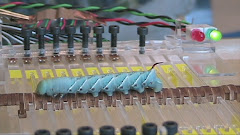This past fortnight was a tough one, for I managed to fracture my right foot two weeks ago. I was immobilized for 4 days before I couldn't stand for anymore home arrest and went back to the laboratory anyway. Indeed, it was a hard time for everything from financial impact to simply getting somewhere. I deeply thank all my friends who helped me survive. I shall get back on my feet very soon.
Well, I am not about to continue this unfortunate story although that was part of what I had to deal with last two week. Since I spent more time at home due to the injury, I started to work on that pile of papers that I "was" supposed to read... and guess what? These were papers about the kind of skeleton that doesn't fracture: hydrostatic skeleton!!
According to my ground reaction forces analysis of caterpillar crawling, hydrostatic skeleton was not active during normal locomotion (manuscript still under review at J Expt Biol). However, we know that Manduca caterpillar can pressurize itself substantially and cast about with precise control. Then where is that switch that "turns on" the hydrostatic skeleton?
Well, I thought I would look into discussions on body pressure of all the major soft-bodied animal systems. In annelids [leeches, earthworms, sandworms...etcc], the cylindrical body is covered by very tough layers of circumferential and longitudinal muscles. Segments are separated by septum muscles which constrict the flow of incompressible coelomic fluid. This type of hydrostat has been modeled and studied for a long time. Deformation can be mapped given that the body volume and pressure are known. Nematodes, on the other hand, does not have circumferential musculature. But they tend to have much higher internal pressure and some evidence suggests that their body wall has very high residual stress. In this model, longitudinal muscles are working against the highly stressed elastic cuticle through the incompressible body fluid. Now, what is the case in caterpillars?
Unlike worms, caterpillar cannot breath through the skin; it has to ventilate via an extensive trachea system. Morphologically, these are significant air cavities open to the exterior. The body cannot be "incompressible" even if the body fluid is. In fact, air bubbles are expelled when a caterpillar crawls underwater. In addition, caterpillars don't have circumferential muscles. To pressurize the body, a caterpillar can do two things: close the spiracles, and compress the body fluid. Indeed, when we try to tear an caterpillar off its substrate, the animal gets shorter and stiffer. However, what can we say about other caterpillar behaviors where the body seems to extend beyond resting length and still maintain body pressure. I suggest a flattening action via the oblique muscles that cause the animals to compress body fluid. Some EMG data might support it, but there is no sufficient proof at this moment. How much compression is require to pressurize the hydrostatic skeleton is totally unclear?
There will be more robotics coming up in the next posting in two weeks I promise! I've been working my leg off (... almost) on the robot radio control system and other robot behavioral integration.
Subscribe to:
Post Comments (Atom)

.jpg)
No comments:
Post a Comment